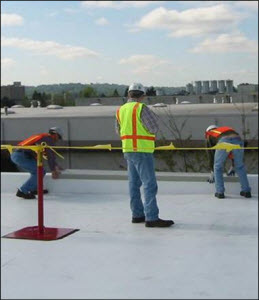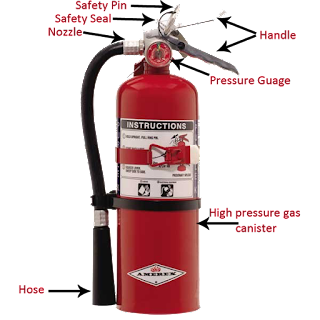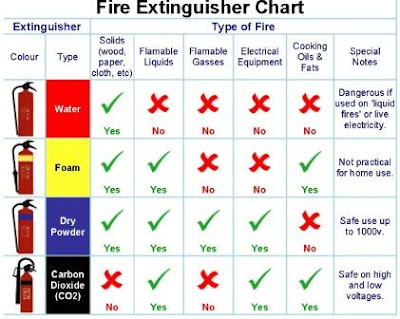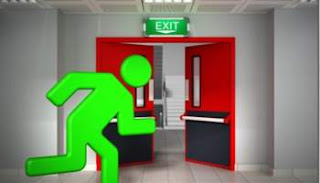Falls from height are the most common cause of fatal injury and the second most cause of common cause of major injuries to employees. Working at height may include work on roof, using ladders or any access platform such as scaffolds or lifting equipment.
The main hazards from Working at Height are Falls i.e, Persons falling and falling equipments.
The main causes of falls from height are:
Catch Platform
Precaution Measures for Working at Height
If the work you're responsible for includes working at height, you need to make sure that:
Avoid working at height wherever possible, if you cant avoid it:
Use work equipment or other measures to prevent falls.
Use work equipment or other measures to minimise the distance and consequences of f fall.
Note:
Ladders are fall hazard too. It should be resting on a stable and level base and should be extending 3 feet above the edge. Standard for ladder erection is 4:1 (for 4m height 1m distance from wall).
The person using ladder should not carrying anything and hands should be free. Three-point contact (two hands and a foot, or two feet and a hand) shall be maintained with ladder while climbing.
Read More »
The main hazards from Working at Height are Falls i.e, Persons falling and falling equipments.
The main causes of falls from height are:
- Failing to recognize the risk.
- Not providing safe system of work and making sure its followed.
- Not providing adequate information, training, instruction or supervision.
- Not using equipment properly or sometimes not using it a all (using chair instead of step ladder).
 |
| Unsafe act may lead to a Fall |
When Fall protection is needed?
During roof work, fall protection is always required when the roof edge is more than 10 feet above the ground or other surfaces. This commonly referred to as, 10 foot rule.
But when any roof is so steep or slippery that an uncontrolled fall would likely happen, fall protection is required at 6 feet.
Types of Fall Protection
Fall protection can be divided into following two categories:
Fall Restraint- equipment that prevents a free fall in the first place.
Fall Arrest- equipment that stops a free fall in progress (in the middle of the fall).
Fall Restraint
Fall restraint system includes three main types;
1) Personal fall restraint
Fall restraint can be a Body Belt or Full Body Harness, which is, connected to an anchor to prevent you from going over the edge of the roof. No matter where you work on the roof.
2) Guardrails
These are most practical on flat or low pitched roofs.
Guardrails must be 39-45 inches high and have a Top rail, mid-rail and toe-board.
Must be able to withstand 200 pounds of force in any direction.
Roof openings are also fall hazard and must be covered or surrounded by a guardrail.
The warning line is installed at 6 feet from roof edge at height of 36-42 inches.
Line is flagged every six feet.
Equipment cannot be stored outside a safe area.
When working outside the safe area or warning line you must wear fall protection or have a safety monitor when working outside the warning line.
You must wear a high visibility garment outside the line and take it off when inside the line.
As for Safety Monitor, his only job is to watch and warn workers of fall danger. Can monitor up to eight workers. There should be clear view between him and workers.
Fall Arrest
Two main types of fall arrest that are used during roofing are;
1) Personal Fall Arrest- Full body Harness, Body Belt.
2) Catch Platform- sometimes used on large buildings,
Other measures include Safety net and Debris net.
Other measures include Safety net and Debris net.
Catch Platform
- Must be no lower than 10 feet from roof edge.
- Must be at least as wide as fall distance but never less than 45 inches in width.
- Must have Guardrails, toe-board and not used for storage of materials.
- Catch platform must conform with scaffold standard.
Personal Fall Arrest
- A full body harness is a common fall arrest system used in roofing.
- A full body harness stops a fall in progress and minimizes the force of fall to your body.
- Waist belts are not allowed because a fall will usually result in injury. Since high force of fall is concentrated at your waist rather than 6 points of full body harness
- The attachment point on a full body harness is D-ring on your upper back.
- It must be an ANSI Class III harness. Recreational climbing harness are not allowed.
- Be sure to use a size that fits you properly.
- Some fall arrest gear comes with shock absorbing lanyard, must be adjusted to prevent hitting to the ground or lower level. Because in a fall, the equipment stretches several feet.

Anchors
Fall arrest gear is only as good as the anchor. An anchor must be able to withstand 5000 lbs of force without failing.Manufactured anchors must be installed according to manufacturer's instructions.
Check pre-installed anchors before using, in fall your life depends anchor holding.
Check pre-installed anchors before using, in fall your life depends anchor holding.
A knot can be used to secure a lifeline to an anchor point only when, you know the breaking strength of the life line and the knot doesn't decrease the strength of the lifeline to below 5000 lbs.
Equipment Do's and Don'ts -Fall Arrest Gear
- Do inspect for wear and damage before use.
- Do remove from service after fall for inspection.
- Dont use to life materials
- Dont attach to a guardrail or hoists.
- Look for the following:
- Webbing, D-rings, Tongue buckle and Ropes for any sign of damage, wear cuts, tears corrosion , cracks etc.
Precaution Measures for Working at Height
If the work you're responsible for includes working at height, you need to make sure that:
- Its properly planned and organised.
- The workers are competent
- You've assessed the risk from working at height, chosen appropriate work equipment and made sure that the staff uses it.
- You've controlled the risk from fragile surfaces.
- Equipment for working at height is properly inspected and maintained.
Avoid working at height wherever possible, if you cant avoid it:
Use work equipment or other measures to prevent falls.
Use work equipment or other measures to minimise the distance and consequences of f fall.
Note:
 |
| Extended above edge-ladder |
Ladders are fall hazard too. It should be resting on a stable and level base and should be extending 3 feet above the edge. Standard for ladder erection is 4:1 (for 4m height 1m distance from wall).
The person using ladder should not carrying anything and hands should be free. Three-point contact (two hands and a foot, or two feet and a hand) shall be maintained with ladder while climbing.



















